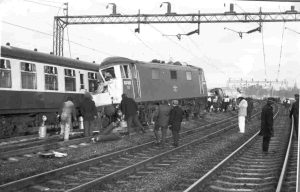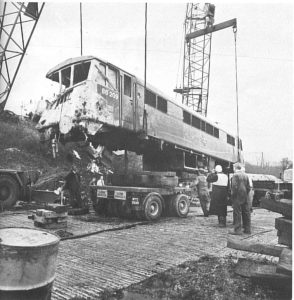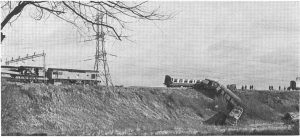Introduction
On October 8, 1980, the tranquil town of Bushey, located in Hertfordshire, England, was shaken by a catastrophic event that would forever change the way railway safety was perceived. The Bushey Derailment of 1980 stands as a poignant reminder of the importance of robust safety measures in the transportation sector, triggering a significant overhaul in railway regulations and practices. This article delves into the details of the incident, its aftermath, and the enduring impact it had on railway safety standards.
The Incident: A Night of Horror
The evening of October 8 started like any other for the residents of Bushey. However, around 11:20 PM, their peaceful night was shattered when an express train traveling from London Euston to Glasgow Central derailed near Bushey station. The derailment occurred due to a set of unfortunate circumstances, primarily stemming from a combination of factors such as poor track maintenance, worn-out equipment, and human error.
The train consisted of seven coaches, with the third and fourth coaches bearing the brunt of the derailment’s impact. The violent collision and derailment resulted in the tragic deaths of three passengers and left several others injured. The severity of the incident was magnified by the fact that it occurred in a densely populated suburban area, exacerbating the impact on the community.
Aftermath and Investigation
In the aftermath of the Bushey Derailment, a comprehensive investigation was launched to determine the root causes of the incident. The findings of the investigation pointed to a series of systemic failures that contributed to the derailment. One of the key factors was the deterioration of the track, which had been neglected in terms of maintenance. The worn-out track structure was unable to handle the forces exerted by the speeding train, leading to the derailment.
Another significant aspect highlighted by the investigation was the inadequate inspection procedures and lack of proper communication among the railway staff. Insufficient communication and failure to relay vital information played a pivotal role in exacerbating the incident, as the personnel on duty were unaware of the deteriorating condition of the track.
The Turning Point for Railway Safety
The Bushey Derailment of 1980 became a turning point in the realm of railway safety. The incident prompted a collective realization that outdated practices and lax safety standards could lead to catastrophic consequences. The tragedy served as a wake-up call for the railway industry, compelling authorities to take immediate action to prevent such incidents in the future.
In response to the disaster, the British Railways Board (BRB) introduced a series of reforms aimed at enhancing safety standards across the railway network. One of the most notable changes was the establishment of a more rigorous track inspection regime, coupled with a mandatory maintenance schedule. Additionally, modernization efforts were initiated to upgrade outdated equipment and infrastructure, ensuring better performance and reliability.
Global Implications
The lessons learned from the Bushey Derailment extended beyond the borders of the United Kingdom. Railway operators and authorities worldwide recognized the need to reevaluate and fortify their safety protocols. The incident served as a poignant reminder of the potential consequences of neglecting safety measures within the transportation sector.
The principles and practices established in the aftermath of the Bushey incident contributed to the development of international safety standards for railways. This incident, tragic as it was, played a significant role in fostering a global culture of safety consciousness within the railway industry.
Legacy and Remembrance
As years have passed, the memory of the Bushey Derailment of 1980 has not faded. It continues to serve as a somber reminder of the cost of complacency in matters of safety. The lives lost and the community impacted are memorialized by both local residents and the broader railway industry.
Every year, on the anniversary of the incident, a remembrance ceremony is held in Bushey to honor the victims and reaffirm the commitment to maintaining high safety standards. This ceremony brings together survivors, families of victims, railway personnel, and local residents to pay their respects and ensure that the lessons learned from the tragedy are never forgotten.
The Bushey Derailment of 1980 was a heart-wrenching event that exposed the vulnerabilities within the railway industry’s safety practices. However, from the darkness of that tragic night emerged a renewed dedication to preventing such incidents from occurring again. The incident served as a catalyst for transformative changes in railway safety protocols, not only in the United Kingdom but also across the globe.
Today, the Bushey Derailment stands as a symbol of the power of tragedy to instigate positive change. It remains an enduring reminder of the importance of vigilance, communication, and stringent safety measures in maintaining the integrity of transportation systems. The lives lost in the incident will forever be honored through the commitment to preventing similar disasters and safeguarding the lives of those who use and rely upon the railways.







